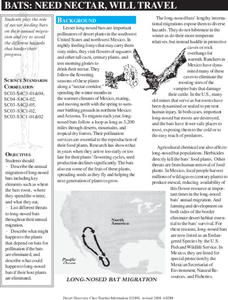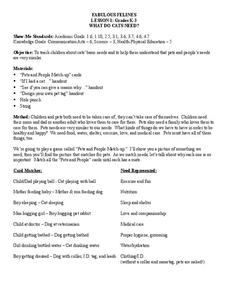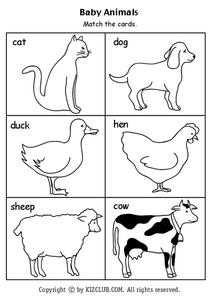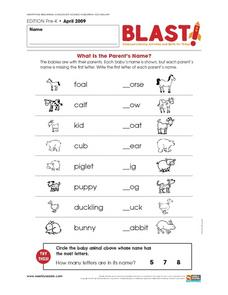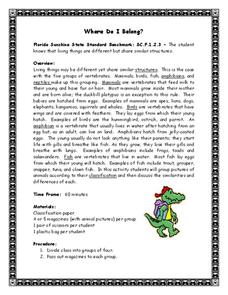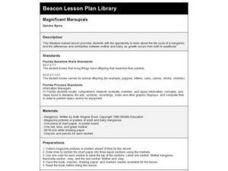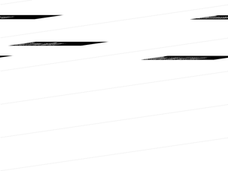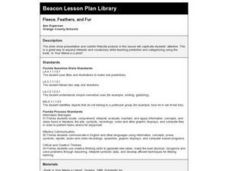Curated OER
Animal Adults and Babies
Students examine how different animals care for their young and how young animals change as they grow. They conduct research on the growth patterns and life cycle of a selected animal, create a realistic baby and adult form of their...
Curated OER
Disney's Animal World Part 2: That's My Baby
Students see that baby animals go through different stages of growth during their life, just as people do. They use the downloadable Cyberlesson Worksheet to reinforce what they have learned about animals and their offspring.
Curated OER
Form and Observation
Use a familiar song and adorable baby animal pictures to teach youngsters about genetic variation. Begin by listening to "Twelve Variations on 'Ah vous dirai-je Maman,'" which you will need to find online (there are several versions...
Curated OER
Draw a Wavy Line
In this tracing a line worksheet, students follow a path in a curvy line to connect five Arctic baby animals to the adult animals.
Curated OER
Bats: Need Nectar, Will Travel
Beginning wildlife biologists become adult bats, baby bats, snakes, owls, bobcats, or land-clearing developers in a grand role-playing activity. In a large open space, they play a game in which they move to designated areas based on what...
Curated OER
Fabulous Felines
Students explore basic needs through discovering that pets and people need very similar things. They will play matching games, sing songs, read books, and discuss the needs of people and animals.
Curated OER
Animals and Animal Babies
Students examine how some animal young are similar to the adult. They look at pictures of various animals and their young and identify if they look similar or not similar to the adult animal, and draw a picture of a baby and parent...
Curated OER
Animals
Second graders define and describe the characteristics of a mammal and a mammal's importance to man. They also describe the life cycle of a frog and compare and contrast a larva and an adult frog. Finally, 2nd graders study and explain...
Curated OER
Baby Animals
In this literacy worksheet, students match the baby and adult animals. They use the cutouts to play a matching game and they be colored also.
Curated OER
What is the Parent's Name?
In this early childhood word recognition worksheet, students read the 8 baby animal's names and fill in the blanks of the matching adult animal's names with the correct letter.
Curated OER
Look Alikes
Third graders compare and contrast the physical features of parents and offspring. In this life science lesson, 3rd graders classify a set of animal pictures according to their similarities. They share and explain their work in class.
Curated OER
Where Do I Belong?
Fourth graders work in groups. They are given magazines. Students cut pictures of five mamals, five birds, five reptiles, five amphibians, and five fish. They place the pictures in a plastic bag. Students switch bags. They are explained...
Curated OER
Brain Power
In this science worksheet, students investigate the anatomy and function of the human brain. Students read facts about the parts of the brain and what each does. Students compare the size of the human brain to that of other animals....
Curated OER
Chips Ahoy: Chip Off the Old Block
First graders compare and contrast adult and baby animals to identify similar characteristics shared by both.
Curated OER
Baby Animals
For this baby animals worksheet, pupils will color and cut out six adult animal cards and six baby animal. Then students will match the adult to the correct baby animal.
Curated OER
Bringing Up Birdy
Students explore biology by creating diagrams of animal life cycles. In this baby bird instructional activity, students view video clips of birds being born from incubation to flying on their own. Students utilize the Internet to...
Curated OER
Magnificent Marsupials
Students have the opportunity to explore the life cycle of a kangaroo, and the differences and similarities between mother and baby as growth occurs from birth to adulthood. They draw pictures of the mother and the joey and compare them.
Curated OER
Desert Tortoise Tale
Learners listen to a reading of the "Desert Tortoise Tale" and complete a maze that highlights the different threats the baby tortoise faces along the way. They discuss the reasons the Desert Tortoise is becoming endangered.
Curated OER
My Family and Me: Our Similarities and Differences
Students are introduced to basic genetic information to discover how they acquired the traits they have. Individually, they develop a family tree and identify the similarities and differences between two poeple. In groups, they examine...
Curated OER
Butterfly Life Cycle
Focused little scientists will flitter their arms back and forth across the room with excitement as they learn the life cycle of a butterfly and how living things grow and change over time.
Curated OER
Introduction of Life Cycles
Fourth graders explore life cycles and the metamorphic process. In this life science instructional activity, 4th graders work in groups to study a group of creatures and metamorphosis. Students view examples of metamorphic and...
Curated OER
Fleece, Feathers, and Fur
Students improve vocabulary and explore predicting and categorizing after reading the book, Is Your Mama a Llama?
Curated OER
A Prickle of Hedgehogs
Students, individually or in groups, conduct research to find information needed to complete a worksheet in which they must match an animal name with 1) the name of its offspring (dog-puppy) and 2) its animal group name (geese-gaggle.)
Curated OER
On the Road Again
Learners trace the migration route of a gray whale. They color and label a map of North America, and using photocopy pictures of a gray whale, they move the whale along the migration route over a ten week period.




